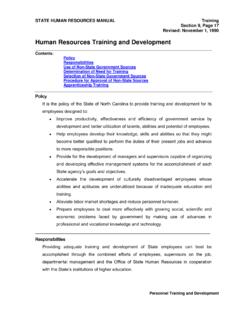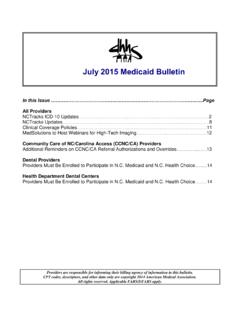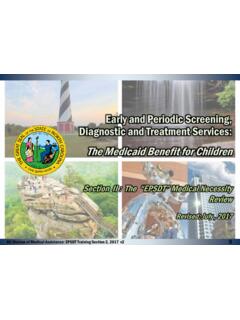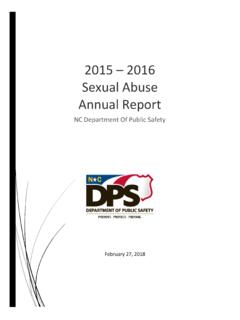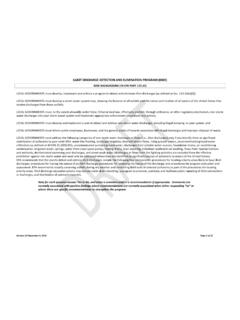Transcription of Working with Individuals with Severe and Persistent Mental ...
1 Working with Individuals with Severe and Persistent Mental illness The DSS Perspective The NC Division of Aging and Adult Services Department of Health and Human Services In collaboration with Center for Aging Research and Educational Services Jordan Institute for Families at the School of Social Work The University of North Carolina at Chapel Hill 1. Beliefs about Mental illness Please indicate whether the belief statement is true, somewhat true, or false. Belief Notes 1. The fact that many, if not most, people True have experienced Mental health problems Somewhat true that mimic or even match some of the False symptoms of a diagnosable Mental disorder, tends to prompt many people to underestimate the painful, disabling, nature of Severe Mental illness .
2 2. Diagnoses of Mental disorders made using True specific criteria are as reliable as those for Somewhat true general medical disorders. False 3. The DSM-IV-TR classifies people according True to a Mental illness and its symptoms. Somewhat true False 4. Shame and stigma are the major reasons True people with Mental health problems avoid Somewhat true seeking treatment, regardless of their race False or ethnicity. 5. Mental illness affects a person's True intelligence, so he/she often enjoys simple Somewhat true and childlike things. False 6. Mental illness is a chronic condition, and True the individual most often deteriorates over Somewhat true time.
3 False 7. A person with Mental illness will probably True not be able to hold a job. Somewhat true False 8. Even if able to work, the person with True Mental illness will probably only be able to Somewhat true hold a low-level, low-stress job. False 2. Belief Notes 9. People with schizophrenia have several True selves, which often talk to one another. Somewhat true False 10. Talking about depression to someone who True is depressed will most likely make it worse. Somewhat true False 11. People who are manic will appear happy True and euphoric. Somewhat true False 12. People with a Mental illness stop taking True their medication because they lack insight Somewhat true or because they intend to sabotage their False treatment.
4 13. Normal aging is often accompanied by True Mental and cognitive disorders. Somewhat true False 14. Mental illness , no less than Mental health, True is influenced by age, gender, race, and Somewhat true culture as well as other factors of diversity. False 15. People with Mental illness are more likely True to be violent than those without. Somewhat true False 16. Best practice states that we must help the True person with Mental illness accept their Somewhat true illness and adjust their personal and False professional goals accordingly. 17. People's willingness to seek help is True contingent on their confidence that Somewhat true personal revelations of Mental distress will False not be disclosed without their consent.
5 3. About the DSM-5. Diagnostic and Statistical Manual of Mental Disorders FIFTH EDITION | DSM-5 . The most comprehensive, current, and critical resource for clinical practice available to today's Mental health clinicians and researchers of all orientations. DSM-5 is used by health professionals, social workers,and forensic and legal specialists to diagnose and classify Mental disorders, and is the product of more than 10 years of effort by hundreds of international experts in all aspects of Mental health. The criteria are concise and explicit, intended to facilitate an objective assessment of symptom presentations in a variety of clinical settings- inpatient, outpatient, partial hospital, consultation-liaison, clinical, private practice, and primary care.
6 DSM-5 provides a common language for patients, caregivers, and clinicians to communicate about the disorders. Anxiety and Depression Refinements Much has remained the same in the areas of anxiety and depression, with refinements of criteria and symptoms across the lifespan. Some disorders included in the broad category of anxiety disorders are now in three sequential chapters: Anxiety Disorders, Obsessive- Compulsive and Related Disorders, and Trauma- and Stressor-Related Disorders. This move emphasizes the distinctiveness of each category while signaling their interconnectedness. One significant change is the developmental approach and examination of disorders across the lifespan, including children and older adults.
7 Some conditions are grouped together as syndromes because the symptoms are not sufficiently distinct to separate the disorders. Others have been split apart into distinct groups. There are over 300 Mental disorders listed in the DSM-5. Each disorder listed is identified with a specific number. These numbers match those published in the International Statistical Classification of Diseases and Related Health Problems. The ICD is another system used to classify Mental and physical disorders. The most current version is ICD- 10. Using the DSM-5, clinicians diagnose a patient and evaluate him or her on five separate axes, or branches of information.
8 This is the multi-axial system. Use of these axes helps the clinician develop a treatment plan that takes all parts of the client's life into consideration. 4. Axis I and Axis II include all of the Mental disorders. Mental disorders diagnosed on Axis I are those that cause the patient significant impairment and are the primary focus of the patient's treatment. The exceptions are personality disorders and Mental retardation, which are diagnosed on Axis II. It is possible for a person to have more than one diagnosis on Axis I. However, the diagnosis that is listed first on Axis I should be the one that represents the patient's main area of difficulty.
9 Axis III is used for reporting general medical conditions ( , cancer or multiple sclerosis). Axis IV is used for reporting psychological and environmental stressors that may affect the diagnosis, treatment, and prognosis ( , family, financial, or employment problems). Axis V is used to report a score given by a clinician on a scale known as the Global Assessment of Functioning (GAF). This score indicates the patient's overall level of functioning. Scores range from 1 to 100, with 100 being superior functioning. A score of 0. means that there was not enough information to give an adequate score.
10 V Codes indicate issues that a person might be dealing with but that are not Mental disorders. Examples might be bereavement, academic problems, and religious identity. Here is an example of what a diagnosis using the DSM IV-TR might look like: AXIS I: Major Depressive Disorder AXIS II: Dependent Personality Disorder AXIS III: Diabetes AXIS IV: Death of a child AXIS V: Current GAF: 60 (moderate symptoms). 5. Experiencing Schizophrenia If I already believe the FBI has bugged my apartment, and is monitoring me, I will see confirmation in this when I go jogging, and see a van drive by very slowly, its driver with an earphone in one ear.
